
How to generate more leads with your website when you're a tech company
Lead generation is often associated with the search for the Holy Grail. 🏆
But why does this quest seem so sacred and how do you get there?
Generating leads is a top priority for many B2B and B2C companies. Whether your sales model is online or traditional, the role of your website is fundamental to capturing leads. In the digital age, your website plays an essential role in attracting new prospects.
Lead generation is part of the inbound process that you must strategically implement.
63% of marketers say that generating traffic and leads is their biggest challenge
📌 Definition: Lead Generation
Lead generation is the use of different marketing techniques to capture visitors. It can be traditional marketing techniques such as trade shows or mailings. Or digital marketing techniques such as sending automated emails, using social networks, web advertising, SEO, etc. The ultimate goal of lead generation is to get information about your visitors to start a sales process.
Publish relevant content on your website to attract your leads
"Content is King", you have probably heard this sentence more than once!
We owe it to our dear Bill Gates, a few years ago.
Content is at the heart of sales and marketing today -and tomorrow- because it allows you to deliver helpful information to your prospects and thus, to capture them. It's not about creating content only when you have a new product or an offer evolution, but implementing a real content strategy to get traffic. And consequently, generate leads.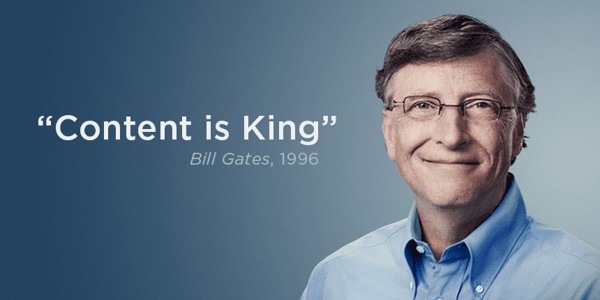
Marketing content is the central pillar of your inbound strategy to acquire leads and convert them.
Making content is to get visibility and notoriety on the web. And thus feed your website to attract visitors. When you create content, you feed the search engines such as Google or Bing and they are greedy for content! The more you publish, the more the search engines will like you. Of course, you have to keep in mind that your content must be of high quality. There is no point in publishing an article every day if it is to write 2 paragraphs, without a title, without an image, without a keyword, and without interest for your target...
Publish useful content, informative or entertaining content. Keep in mind that you have to teach your audience something. Obviously, your content is about your business but don't always talk about what you are selling. This is not what the visitor wants, he wants information on a subject of interest. They want to come away smarter, having learned something.
Finally, remember: We always share more useful and intelligent content rather than advertising!
📌 Definition: Inbound Marketing
Inbound marketing is based on a content creation strategy that attracts visitors in order to convert them into leads and then into customers, thanks to techniques like marketing automation, lead nurturing, and content creation.
Source HubSpotSource HubSpot

Offer downloadable content or Premium/Gated content to turn your visitors into leads
Publishing informative content is good, but at some point, you'll have to know WHO your visitors are, capture them, and therefore generate leads (yes, that's the whole point of this article!). And this is not a magic trick. So how do you do it?
At this stage, you need to set up conversion forms.
You need to offer high-value conversion content in exchange for contact information.
Offer downloadable content, which you will send via emails (in exchange for an email address) such as ebooks, guides, white papers, comparisons, presentations, case studies, demos, and more. It can also be Premium / Gated content that offers content directly after exchanging contact information.

In the inbound language, conversion content is called "Premium Content" or "Gated Content"
Very often, the mistake B2B companies make is to believe that a simple form wondered on their site, offering a demo or free trial, is enough to generate leads. Not true! Let's face it, it doesn't work like that.
This is where you need to set up forms and landing pages that allow your visitors to give you at least their email addresses (and other information you deem relevant for your business) in exchange for which they will get high value-added content. Your premium content should be offered in strategic places on your website or blog. Very often, the reader of one of your articles wants to go a little further to dig into the subject, so it is there, in the middle or at the end of your article that you will offer Premium content.
Here is an example of a call to action on premium content, on HubSpot's blog. An article on lead generation offers to view a recorded webinar and/or download a free ebook.
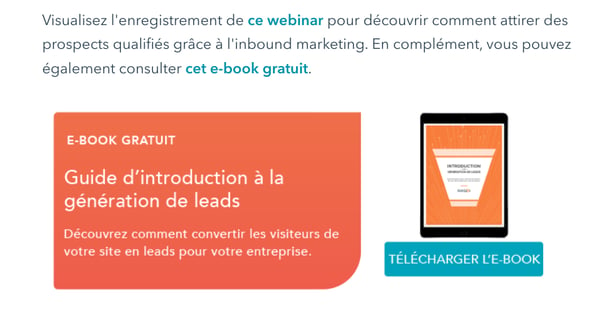
Then follows the appearance of a form to fill out if you want to have access to premium content. "I'll give you my content if you give me your email address".
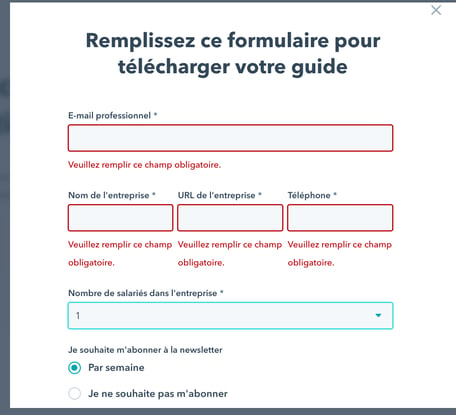
Optimize your website's SEO to get more leads
SEO is a very important basis for your presence on the web. Who has never dreamed that his website appears on the first page of Google?
When you know that there are more than 80 000 requests every second, that is to say, 6.9 billion per day on Google. Therefore you HAVE to work on the SEO side so that people can actually see your website.
📌 Definition - SEO
SEO is the acronym for Search Engine Optimization and can be defined as the art of positioning a website in the first natural results of search engines. In French, SEO is referred to as "référencement naturel".
Source: Marketing Definitions
There are three main pillars of SEO:
- The technical pillar: Quality code, well-constructed website, page loading time, logical tree structure and following a semantic cocoon, optimized display on mobile, no broken links, etc.
- The content pillar: As mentioned above, you need rich content, published regularly, quality images, links to other influential websites, well-constructed content with titles, subtitles, bullet lists, etc.
- The notoriety pillar: Your pages must be shared on other sites. Thus, search engines will notice that it is a reference site, qualitative and you will increase your natural referencing.
To learn more about SEO (this article is in French).

Improving your SEO is also and above all about finding the right keywords and inserting them in your content. How to do it?
A little method and some tools are below:
First, you have defined your Personas and you now know their favorite subjects. Now you have to choose the keywords that you will position in your content, in the right places, and in an intelligent way.
- Make a list of about ten keywords, in relation to what emerges from the study of your Personas,
- Go and see what your competitors are using,
- Go to Google Trends to see the popularity of your keywords in a specific geographical area,
- Go to Ubbersuggest or Google Keyword Planner to see the search volume of your keywords,
- Go to Answer The Public to see common phrases and questions wondered about your keywords,
- Type in a keyword on Bing, Google, or other search engines to see what comes up the most.
Researching and inserting keywords is a long process and it is far from being the only pillar of good natural referencing.
61% of B2B decision-makers start their purchasing process from a search engine. The referencing of your website in B2B is therefore a major issue
Your website must follow an Acquisition Funnel for your leads and match your Buyer Personas
To generate leads, you need to think of your website as a funnel. It is also called the "acquisition funnel" in marketing. What is it and how does it work?
📌 Definition - Acquisition Funnel
The marketing funnel is a way to represent the buying journey of your customers or, what amounts to the same thing, the acquisition tunnel. It highlights the different steps your potential customer goes through between the moment they discover your brand and the moment they buy.
Source : La fabrique du Net
One of your priorities is to know the purchase path of your future customers. This funnel is composed of several stages through which your customers will pass:
- From the stage of a simple visitor on your website,
- Then lead, as soon as the contact enters your CRM because he has given you his details,
- Then Marketing Qualified Lead, or MQL, when you have qualified the lead at a marketing level,
- Then Sales Qualified Lead, also known as SQL, when you qualify your lead at a sales level,
- This lead then becomes an opportunity and is then managed by your salespeople,
- And finally, the customer stage, when the sale is made. Well done!
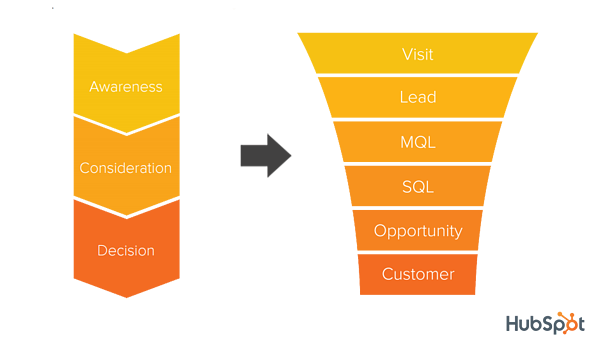
- The first stage is Awareness, which consists of arousing the interest of your audience and attracting your prospects to content that teaches them something (articles, videos...).
- The second stage is the Consideration stage, which consists of converting your prospects into leads with more technical content (ebooks, tools, etc.).
- The third stage is Decision. It consists in transforming leads into customers with content about your offer (webinars, meetings...).
Your acquisition funnel is composed of different steps that you must master to adapt your website.
With each of the funnel steps defined, once you have attracted visitors, you will need to set up calls-to-action that take them to a landing page. On this page, they will fill out a form in exchange for their contact information. Each phase of the funnel offers different premium content. The further you move towards the decision, the more you talk about your products and services as a solution to your Persona's need.
📌 Definition - Buyer Persona
The buyer persona is the semi-fictional representation of your ideal customer based on biographical and demographic information, psychological criteria, motivations, or even goals. Source: Hubspot Blog
You've probably already heard about the evolution of the "acquisition funnel" which has now become the "Flywheel", more focused on the customer.
The Flywheel defines the customer, not as an endpoint but rather as the center of all Marketing, Service, and Sales actions. This doesn't make the acquisition funnel obsolete, but it does make it evolve in a more comprehensive and unified way to represent the forces that affect your business growth.
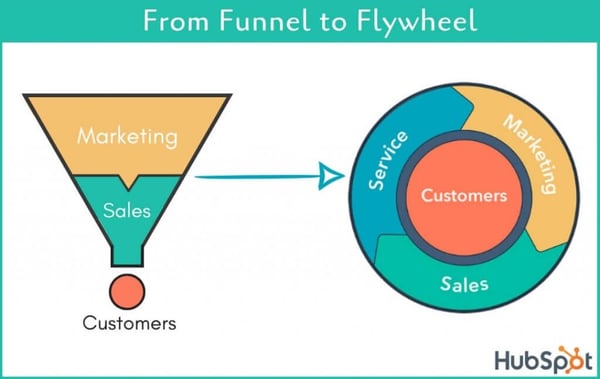
CONCLUSION
You will have understood that your website is much more than a simple window on your company or simply a store of your products or services. Your website is a lead machine and you must feed this machine to make it work well!
A website must:
- Be aligned with your brand,
- Showcase your value proposition,
- Promote your products/services,
- Be consistent with your audience, their needs, and interests.
Always remember to work from your Personas. They are at the center of your actions and must guide the design of your website. That's why the user experience must be built according to your "customer journey". You must offer them a quality experience and unique content.
Build a customer experience consistent with your "customer journey", the customer journey of each of your Personas
In a few words: Your website must be efficient at all levels to generate leads and engage in an inbound marketing process. Obviously building a powerful website requires powerful tools. A solid and easy-to-use Content Management System (CMS), state-of-the-art SEO tools, a relevant content strategy, and much more!

We answer your frequently asked questions about generating leads through your website
IS IT A GOOD PRACTICE TO PUT THE BLOG ON MY WEBSITE, OR IS IT BETTER TO HAVE A SEPARATE BLOG (WITH A DIFFERENT DOMAIN NAME)?
There is no universal answer to this question. What is certain is that if you are just starting to produce content, and given the effort it requires, we advise you to put your blog with your website. This will make it easier for you to feed both and search engines will find it easier to recognize you and therefore to reference you naturally.
HOW MANY WORDS SHOULD I WRITE PER PAGE OF MY WEBSITE?
The minimum recommended is 1,200 words so that search engines appreciate your content (yes, we told you above, they are greedy!). And then some surveys prove that the results are more convincing when you write more than 3,000 words. Obviously, writing 3,000 words on a product or service page is often a bit complicated. So don't panic! Keep in mind that you need at least 1,200 words and ideally on your content such as blog posts and others, try to do more! Note that this is not the ONLY thing that counts in SEO!
HOW TO BE SURE TO CHOOSE THE RIGHT KEYWORDS?
There are several ways to work on your keyword strategy. According to your competitors or according to your personas. The best way is to do a mix of both (but obviously it is more time-consuming and complex). Start from the study of your personas to know their interests and their language, and therefore know what they are looking for on the web. Then, start again from your competitors' websites, look at their H1 and H2 titles, the topics covered, etc. We do not say there to do exactly the same as the attention! But be inspired.
Keywords change regularly, and the results you get today will not be the same in 6 months, so make a watch at least twice a year. To do your keyword research, use different tools, mentioned in the text above.
ARE THERE OTHER WAYS TO GENERATE LEADS?
Of course, there are other ways but your website remains an essential hub in your acquisition strategy. You can capture leads by using paid lead generation techniques such as SEA / Paid Search (search engine advertising), Paid Social (social media advertising), or by doing events/webinars co-organized with other companies, by setting up an ambassador program (your customers promote you), by participating in physical or virtual trade shows, by doing partnerships or reseller programs, etc. There are many ways to generate leads and your website is a very powerful channel if it is well-built.
If you have any other questions, feel free to leave a comment or contact us directly 😊




Comment this article